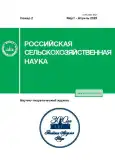Amino acid content in spring common wheat grain
- Authors: Ashadullin D.F.1, Ashadullin D.F.1, Vasilova N.Z1, Zuev E.V2, Hajrullina A.R1
-
Affiliations:
- Tatarian Agricultural Research Institute - autonomous structural subdivision of the Federal Research Center of the Kazan Scientific Center, Russian Academy of Sciences
- Federal Research Center the Vavilov All-Russian Institute of Plant Genetic Resources (VIR)
- Issue: No 2 (2023)
- Pages: 35-39
- Section: Articles
- URL: https://journals.rcsi.science/2500-2627/article/view/144602
- DOI: https://doi.org/10.31857/S2500262723020084
- EDN: https://elibrary.ru/APGNYA
- ID: 144602
Cite item
Full Text
Abstract
Keywords
About the authors
Damir F. Ashadullin
Tatarian Agricultural Research Institute - autonomous structural subdivision of the Federal Research Center of the Kazan Scientific Center, Russian Academy of Sciences
Email: nsm2308@yandex.ru
420059, Kazan, Orenburgskii tr., 48
Danil F. Ashadullin
Tatarian Agricultural Research Institute - autonomous structural subdivision of the Federal Research Center of the Kazan Scientific Center, Russian Academy of Sciences420059, Kazan, Orenburgskii tr., 48
N. Z Vasilova
Tatarian Agricultural Research Institute - autonomous structural subdivision of the Federal Research Center of the Kazan Scientific Center, Russian Academy of Sciences420059, Kazan, Orenburgskii tr., 48
E. V Zuev
Federal Research Center the Vavilov All-Russian Institute of Plant Genetic Resources (VIR)190031, Sankt-Peterburg, Bolshaya Morskaya, 42-44
A. R Hajrullina
Tatarian Agricultural Research Institute - autonomous structural subdivision of the Federal Research Center of the Kazan Scientific Center, Russian Academy of Sciences420059, Kazan, Orenburgskii tr., 48
References
- Лысиков Ю. А. Аминокислоты в питании человека // Экспериментальная и клиническая гастроэнтероло-гия. 2012. №2. С. 88-105.
- Hou Y., Wu G., Nutritionally Essential Amino Acids // Advances in Nutrition. 2018. Vol. 9. No. 6. P. 849-851. doi: 10.1093/advances/nmy054.
- Перспективы развития глубокой переработки зерна / Н. Р. Андреев, В. Г. Гольдштейн, Л. П. Носовская и др. // Достижения науки и техники АПК. 2020. Т. 34. № 11. С. 98-103. doi: 10.24411/0235-2451-2020-11115.
- Yigit A., Erekul O. Antioxidant Activity and Essential Amino acid Content of Bread Wheat (Triticum aestivum L.) Varieties // Journal of Agricultural Sciences. 2023. Vol. 29. No. 1. P. 130-141. doi: 10.15832/ankutbd.999660.
- Kaur R., Kaur H., Srivastava P. Role of tryptophan content in determining gluten quality and wheat grain characteristics // Heliyon. 2022. Vol. 8. No. 10. Article10715. URL: https://www.sciencedirect.com/science/article/pii/S2405844022020035 (дата обращения: 05.02.2023). doi: 10.1016/j.heliyon.2022.e10715
- Vogel K. P., Johnson V. A., Mattern P. J. Reevaluation of Common Wheats from the USDA World Wheat Collection for Protein and Lysine Content (1975) // Historical Research Bulletins of the Nebraska Agricultural Experiment Station (1913-1993). 1993. URL: http://digitalcommons.unl.edu/ardhistrb/172 (дата обращения: 05.02.2023)
- Маркс Е. И., Лейболт Е. Л., Заушицына И. Г. Электрофоретические спектры белков и качество урожая пшеницы // Вестник НГАУ (Новосибирский государственный аграрный университет). 2015. №4(37). С. 26-34.
- Формирование химического состава зерна яровой пшеницы при различном уровне минерального питания / Д. В. Чикишев, Н. В. Абрамов, Н. С. Ларина и др. // Известия вузов. Прикладная химия и биотехнология. 2020. Т. 10. № 3. С. 496-505. doi: 10.21285/2227-2925-2020-10-3-496-505.
- Горянина Т. А., Макушкин А. Н. Качество зерна сортов озимых тритикале селекции Самарского НИИСХ // Аграрный научный журнал. 2021. №7. С. 4-8. doi: 10.28983/asj.y2021i7pp4-8.
- Асеева Т. А., Зенкина К. В., Ломакина И. В. Хозяйственная и биологическая характеристика перспективного универсального сорта яровой пшеницы Далира // Достижения науки и техники АПК. 2020. Т. 34. № 6. С. 59-64. doi: 10.24411/0235-2451-2020-10611.
- Белышкина М.Е. Биохимический состав семян раннеспелых сортов сои и его вариабельность в зависимости от сортовых особенностей и метеорологических условий вегетационного периода // Вестник Ульяновской государственной сельскохозяйственной академии. 2020. № 3 (51). С. 33-40.
- Influence of seven levels of chemical/biostimulator protection on amino acid profile and yield traits in wheat / Iwaniuk Р., Konecki R., Kaczynski P., et al. // The Crop Journal. 2022. Vol. 10. No. 4. P. 1198-1206. doi: 10.1016/j.cj.2021.12.007.
- Jiang X., Wu P., Tian, J. Genetic analysis of amino acid content in wheat grain // Journal of Genetics. 2014. Vol.93. P. 451-458. doi: 10.1007/s12041-014-0408-6.
- Fontaine J., Schirmer B., Horr J. Near-Infrared Reflectance Spectroscopy (NIRS) Enables the Fast and Accurate Prediction of Essential Amino Acid Contents.2. Results for Wheat, Barley, Corn, Triticale, Wheat Bran / Middlings, Rice Bran, and Sorghum // Journal of Agricultural and Food Chemistry. 2002. Vol. 50. No.14. Р. 3902-3911. doi: 10.1021/jf011637k.
- Near-Infrared Reflectance Spectrophotometry (NIRS) Application in the Amino Acid Profiling of Quality Protein Maize (QPM) / E. O. Alamu, A. Menkir, M. Adesokan, et al. // Foods. 2022. Vol. 11. No. 18. Article 2779. URL: https://www.mdpi.com/2304-8158/11/18/2779 (дата обращения: 07.02.2023). doi: 10.3390/foods11182779.
- Методика государственного сортоиспытания сельскохозяйственных культур. Технологическая оценка зерновых, крупяных и зернобобовых культур / под общ. ред. М. А. Федина. М.: Госагропром СССР, 1988. 121 с.
- Доспехов Б. А. Методика полевого опыта (с основами статистической обработки результатов исследований) / Изд. 6-е, стер., перепеч. с 5-го изд. 1985 г. М.: Альянс, 2011. 350 с.
- Simon Sarkadi L. Amino acids and biogenic amines as food quality factors // Pure and Applied Chemistry. 2019. Vol. 91, Issue 2. Р. 289-300. doi: 10.1515/pac-2018-0709.
- Protein content and amino acid composition of commercially available plant-based protein isolates / S.H.M. Gorissen, J.J.R. Crombag, J.M.G. Senden, et al. // Amino Acids. 2018. Vol. 50. P. 1685-1695 doi: 10.1007/s00726-018-2640-5.
- Galili G., Amir R., Fernie A. R. The Regulation of Essential Amino Acid Synthesis and Accumulation in Plants // Annual Review of Plant Biology. 2016. Vol. 67 P. 153-78. doi: 10.1146/annurev-arplant-043015-112213.
Supplementary files









